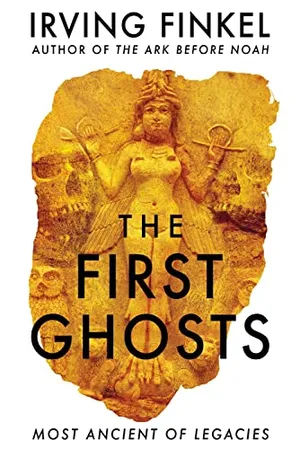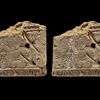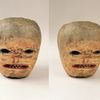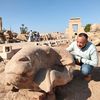A curator at the British Museum details the spooky find in a new book.
:focal(647x527:648x528)/https://tf-cmsv2-smithsonianmag-media.s3.amazonaws.com/filer_public/59/29/59290b31-1666-4697-bd0e-590c7519131c/ghost_tablet.jpg)
The tablet depicts a male ghost being led back to the afterlife, curator Irving Finkel says. Photo: British Museum / Line drawing: James Fraser and Chris Cobb for The First Ghosts
–
/https://tf-cmsv2-smithsonianmag-media.s3.amazonaws.com/accounts/headshot/Livia_lg.jpg) Livia Gershon, Daily Correspondent
Livia Gershon, Daily Correspondent
2021 Oct 22
–
A tablet made in ancient Babylon around 1500 B.C.E. may be the earliest known depiction of a ghost, a top scholar of ancient Middle Eastern inscriptions argues in a new book.
The clay tablet is part of a guide to exorcising ghosts held in the collections of the British Museum, reports Dalya Alberge for the Observer. Irving Finkel, a curator in the London museum’s Middle Eastern department and the author of the forthcoming book The First Ghosts: Most Ancient of Legacies, says the image on the tablet is only visible when viewed from above under a light. The museum acquired the artifact in the 19th century, but it has never been exhibited.
“You’d probably never give it a second thought because the area where the drawings are looks like it’s got no writing,” Finkel tells the Observer. “But when you examine it and hold it under a lamp, those figures leap out at you across time in the most startling way.”

The First Ghosts
A rich history of ancient ghosts and ghost stories from a British Museum curator
–
The tablet is small enough to fit in a person’s hand. As Patrick Pester reports for Live Science, at least half of it is missing. But the object still holds carefully detailed instructions on getting rid of pesky ghosts. The directions call for the exorcist to make figurines of a man and woman; prepare two vessels of beer; and, at sunrise, speak ritual words calling on the Mesopotamian god Shamash, who was responsible for bringing ghosts to the underworld. Finkel says the idea was to transfer the ghost into one of the figurines.
The text’s final line urges readers to “not look behind you!” This warning is probably intended as an instruction aimed at the figurines entering the underworld, but it’s possible it’s directed at the exorcist.
According to Finkel, the drawing was most likely made by a master craftsperson who was highly skilled in drawing in clay. The tablet may have been held in an exorcist’s library or a temple.
There was a whole school of specialist magic, which was to appease ghosts and to send them back where they belong without any further trouble.
Finkel tells Artnet News’ Amah-Rose Abrams that he decided to write the new book after reading a history of ghosts that began in the 18th century.
“I suddenly thought, ‘Well, what about our stuff? What about Mesopotamia?’” he says.
In early civilizations like Mesopotamia, people expected to encounter ghosts, the scholar explains. Ancient chroniclers Pliny, Lucian and Plautus all reference ghosts in their writings, per History.com; some observers even left instructions on how to get rid of particular sorts of spirits.
The Babylonian tablet featured in the new book focuses specifically on removing an older male ghost by having a young woman lead him to the underworld.
“It’s obviously a male ghost and he’s miserable,” Finkel tells the Observer. “… You can’t help but imagine what happened before. ‘Oh God, Uncle Henry’s back.’ Maybe Uncle Henry’s lost three wives. Something that everybody knew was that the way to get rid of the old bugger was to marry him off. It’s not fanciful to read this into it. It’s a kind of explicit message. There’s very high-quality writing there and immaculate draughtsmanship.”
The First Ghosts also describes objects like bronze amulets used to get rid of ghosts and rituals, at least one of which involved a human skull.
In a 2018 British Museum video, Finkel said that ancient Mesopotamians relied on funerary rituals to keep the dead from rising again. Ghosts, having been deprived of eternal rest, were generally considered objects of sympathy.
“So there was a whole school of specialist magic, which was to appease ghosts and to send them back where they belong without any further trouble,” he added.
All major ancient civilizations held beliefs involving the survival of souls after bodily death, wrote Joshua J. Mark for World History Encyclopedia in 2014. In many cases, these souls belonged to a realm of the dead but might return to the living world due to improper funeral rites or unfinished business. Ghost stories with similar themes can be found in ancient China, Mesoamerica, Egypt, India, Greece, Ireland, Scotland and Rome.
In Mesopotamia, souls could return as ghosts that manifested themselves as sickness among the living. Doctors called on those suffering from these kinds of illness to confess any sins that may have summoned the dead before treating them with spells to placate the ghosts.
Despite his field of studies, Finkel has no personal experience with spirits himself.
“I would like to see a ghost. I’ve never seen one. It’s very annoying to me,” he said in the video.
–
–
/https://tf-cmsv2-smithsonianmag-media.s3.amazonaws.com/accounts/headshot/Livia_lg.jpg)
Livia Gershon | | READ MORE
Livia Gershon is a daily correspondent for Smithsonian. She is also a freelance journalist based in New Hampshire. She has written for JSTOR Daily, the Daily Beast, the Boston Globe, HuffPost and Vice, among others.Ancient CivilizationsArchaeologyArtifactsCool FindsDeathHalloweenMagicMiddle East Rituals and Traditions
–
Most Popular
 3,500-Year-Old Babylonian Tablet May Contain Earliest Known Depiction of a Ghost
3,500-Year-Old Babylonian Tablet May Contain Earliest Known Depiction of a Ghost When People Carved Turnips Instead of Pumpkins for Halloween
When People Carved Turnips Instead of Pumpkins for Halloween Underwater Eruption Off France’s Mayotte Island Gave Rise to a New Colossal Seamount
Underwater Eruption Off France’s Mayotte Island Gave Rise to a New Colossal Seamount This Tiny Crustacean Trapped in Amber Tells a Different Story About Crab Evolution
This Tiny Crustacean Trapped in Amber Tells a Different Story About Crab Evolution Ancient Stone Ram Heads Unearthed on Egypt’s ‘Avenue of the Sphinxes’
Ancient Stone Ram Heads Unearthed on Egypt’s ‘Avenue of the Sphinxes’

Explore
Subscribe
Newsletters
Our Partners
- Smithsonian Institution
- Smithsonian.com
- Air & Space Magazine
- Smithsonian Store
- Smithsonian Journeys
- Smithsonian Channel
- Smithsonian Books
Terms of Use
- About Smithsonian
- Contact Us
- Advertising
- RSS
- Member Services
- Sustainability
- Terms of Use
- Privacy Statement
- Cookie Policy
–
© 2021 Smithsonian Magazine
Privacy StatementCookie PolicyTerms of UseAdvertising NoticeManage My Data
–
–
–
(For the source of this, and many other equally intriguing and important articles, please visit: https://www.smithsonianmag.com/smart-news/3500-year-old-babylonian-tablet-may-hold-earliest-known-ghost-image-180978923/)








